‘As regards the Cathedral – it is, to my mind essentially a stage piece & I said I wd not allow it in a hall or church till it was fully established on the stage.’ So wrote Ralph Vaughan Williams to his fellow composer and friend Rutland Boughton in May 1951, of his ‘operatic morality’ The Pilgrim’s Progress, which draws upon the non-Conformist John Bunyan’s eponymous Christian allegory of a pilgrimage, on a path strewn with pitfalls, to the Holy City as described in the Apocalypse of St John.
One certainly could not argue that the work has now become ‘fully established’ on the stage, so what the composer would have made of this performance of The Pilgrim’s Progress by British Youth Opera, in Gloucester Cathedral, is a moot point. But, given that productions and performances are few and far between, this Three Choirs Festival manifestation was very welcome indeed. And, both its allegorical nature – as characters fight for the salvation of their souls – and Vaughan Williams’ own ‘cheerful agnosticism’ and engagement with English choral traditions, perhaps makes one associate the work more with choral music festivals and cathedral naves than with the opera house.
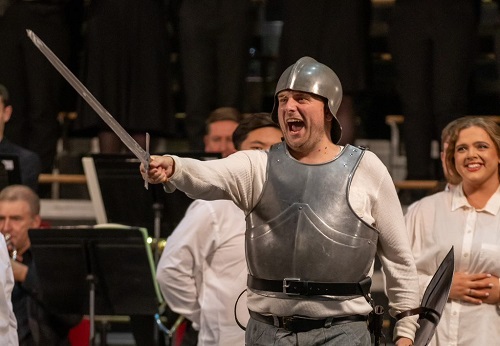
That said, Vaughan Williams saw The Pilgrim’s Progress as representing a universal, rather than a specifically Christian, experience, writing in the aforementioned letter: ‘I, on purpose, did not call the Pilgrim “Christian” because I want the work to be universal and apply to any body who aims at the spiritual life whether he is Xtian Jew, Buddhist, Shintoist or 5th day Adventist.’ Will Kerley’s production, however, perhaps understandably given the context, made much of Christian motifs, from the start when the Pilgrim cast aside his burden at the foot of the Cross, to the close when stage-hands re-purposed wooden crates in the form of a Cross, which was draped by the Evangelist with the Pilgrim’s shabby grey cloak, itself embroidered with a large white cross.
Secular and spiritual were brought together through allusions to the Crusades, the purposeful rhythmic tread of the arming scene initiating the bestowing of chain mail, shield and sword – the latter brandished exultantly – upon the departing pilgrim, and trumpets gleaming above the strains of the psalm tune, ‘York’. Such gestures were translated, with less success, to a WW1 battlefield, when the Pilgrim, wounded by Apollyon, was tended by Branch and Cup bearers dressed as field medics. This reminded me that Vaughan Williams’ teacher, Hubert Parry – who had himself, in 1916, nurtured Blake’s call for a national ‘pilgrimage’ in Jerusalem – had urged his pupil to compose choral music, ‘like an Englishman and a democrat’.
If The Pilgrim’s Progress has had a rather problematic reception history – as I discussed with the conductor of this British Youth Opera performance, Charlotte Corderoy – then Vaughan Williams was aware that the atypical nature of the work would unsettle some listeners, telling his future wife, Ursula Wood, after the Royal Opera House/Festival of Britain premiere in 1951: ‘They won’t like it, they don’t want an opera with no heroine and no love duets –and I don’t care, it’s what I meant, and there it is.’ Boughton described it as a ‘magnificent anomaly’, and it does indeed fuse diverse forms – among them medieval mystery play, masque and opera.
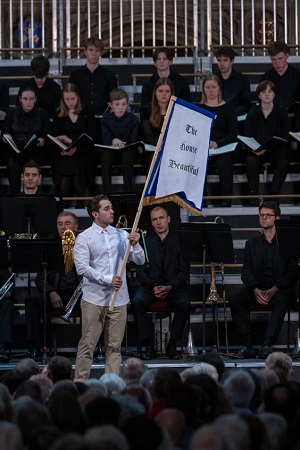
What unites such ‘anomalies’ is, perhaps, ritual. The agnostic composer spent forty years of his life seeking a way to evoke the religious experience and the mystery of faith and the sacred without directly employing the imagery of the latter, and in this regard the rituals and rites that are an essential part of opera are at the root of The Pilgrim’s Progress even as it seems to reject the traditions and conventions of the genre. In Will Kerley’s semi-staged production, the consistent highlighting of ritual – the various ‘ceremonies’ involving ornaments and acolytes, the gestures such as the anointing of the Pilgrim by the Interpreter, or the ‘ceremonial’ piercing of his heart by the Celestial Messenger, even the entrances of the gold-winged cherubic standard bearer, whose banners announced the title of each scene – very much made one reflect on questions of genre, reminding this listener of the way that Britten, in his Church Parables, brought together the practices of medieval theatre and Japanese Nō.
In this regard, it’s interesting to note that in a letter to the BBC’s Sir Steuart Wilson in August 1948, Vaughan Williams’ both acknowledged criticisms that The Pilgrim’s Progress was not ‘dramatic’, and made reference to essential operatic practice of ritual, in the works of Wagner and Mozart: ‘Of course the obvious criticism is that it is not ‘dramatic’– but then it is not meant to be. Whether this is a good excuse I do not know. It is more of a ceremony really than a drama. This applies especially to the end of Act I. I do not know whether Act I of ‘Parsifal’ is any precedent for this but even here there is a certain amount of what dramatic experts call ‘conflict’ when Amfortas makes his rather melodramatic interruption. On the other hand my ceremony only takes about seven minutes whereas Wagner takes over half an hour. Perhaps the initiation scene from the ‘Magic Flute’ is a nearer parallel.’
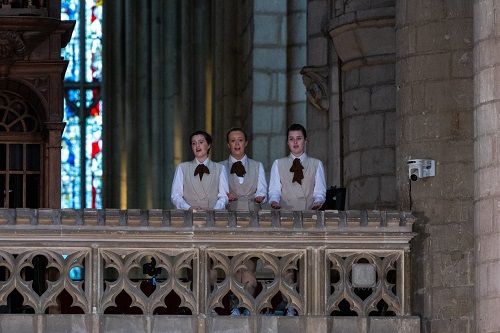
If I seem to digress, then it is just because such Kerley’s semi-staging fruitfully emphasised the ritualistic aspects of the work but was not entirely successful in overcoming the limitations imposed by the restricted space. The musicians of the Royal Philharmonic Orchestra were seated in an unconventional arrangement, nearly all of the ensemble positioned to the left of Corderoy, with cellos and double basses behind the violins, and only the trombones and tuba occupying the right, from the viewers’ perspective, of the platform. The action was presented in front of the latter, but sight lines – unless, presumably, one was seated in the front few rows – were not particularly good, especially as the Pilgrim was sometimes seated, or retreated to the far stage-left, between two grand columns. Could the platform have been raised higher? Might the Three Choirs Festival Youth Chorus have been moved a little to one side to allow for some use of the raked seating area? Kerley did position some singers at the top of the choir screen – the Three Shining Ones who descend (in ‘The House Beautiful’ episode) to prepare the Pilgrim for his journey, and the Voice of a Bird (in ‘The Shepherds of the Delectable Mountains’). But, while from my seat in the middle of nave I had a fairly decent view of the staging, I was in front of the television monitors that aided those seated further back – whom, I suspect, could see little of the staged action directly.
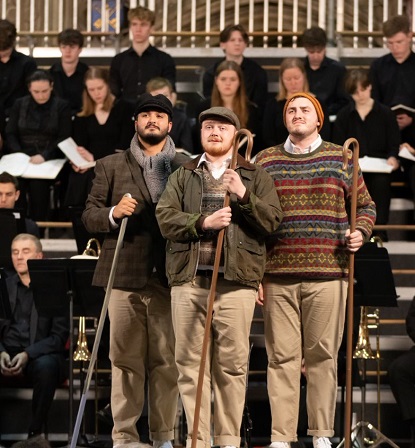
What came across powerfully in Kerley’s production was the motif of the ‘quest’ – a motif that was a recurring spiritual and artistic element in Vaughan Williams’ work, from the 1906 Towards the Unknown Region, through 1909 Songs of Travel, the explorations of A Sea Symphony (1903-09), the oratorio Sancta Civitas (1926) – performed on the opening night of this Three Choirs Festival – and the Sinfonia Antartica, first performed in 1953.
Vaughan Williams’ score requires no less than 40 roles, which is a large number even allowing for the doubling and tripling or roles. Here, though, the role of the Pilgrim was not doubled with the figure of Bunyan, as is sometimes the case (and as it was when English National Opera performed The Pilgrim’s Progress in 2012, with Martyn Brabbins at the helm). Baritone Ross Cumming, dressed in grey rags and carrying a spider’s web of burdensome bags, like a modern-day vagabond, and the red book that inspires his pilgrimage, conveyed the Pilgrim’s anguish with unwavering intensity and fervour. Perhaps he was a little too intense at the start, leaving little room for the growing anguish of the journey. But, Cumming conveyed the solemnity of the vocal line, the rhythms of which bear the inflections of the archaisms of the language of James I’s Bible, and captured the tenor of exalted resolve – especially when he attained the Key of Promise, the miraculous means by which he can extricate himself from prison. And, in that prison scene, which quotes extensively from Psalms 23 and 139, Cummings powerfully reinforced the Pilgrim’s identity, trumpet, brass and woodwind adding to the strength of his declamation, “Open me to the gates of righteousness”. There was similar spiritual depth, drawing on the biblical inflections of the text, in the Pilgrim’s prayer in the ‘Shepherds on the Delectable Mountains’ episode, as he called to his God, “Preserve me, O Lord, from the deep waters”, when preparing to cross the river to the Celestial City. This Pilgrim’s deliverance, whatever physical and moral challenges were placed in his path, seemed assured from the first, but this did not lessen the spiritual struggle faced and realised.
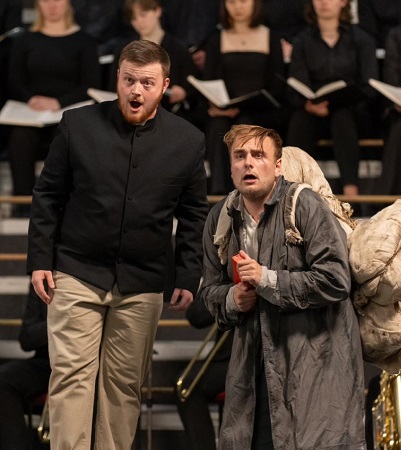
The separation of the figures of Bunyan and the Pilgrim also served to make the drama more universal, particularly given the superlative performance of baritone Emyr Lloyd Jones as both Bunyan and the Evangelist. He brought real presence and nobility to both roles, and his excellent projection and diction were also strongly felt in Watchful’s Nocturne, a superb aria which Lloyd Jones made stand apart from the surrounding arioso and declamation. His contribution as the First Shepherd was no less purposeful, alongside Armand Rabot and Matthew Curtis, the latter a late replacement for the indisposed Henry Ross). Like the Three Shining Ones (Issy Bridgeman, Charlotte Jane Kennedy and Angelina Dorlin-Barlow), the Three Shepherds again put one in mind of The Magic Flute whose Three Ladies and Three Boys guide and comfort another ‘pilgrim’.
Curtis was also a stentorian Usher in the Vanity Fair scene, introducing Jia Huang’s Lord Hate-Good with dignified aplomb, and he returned, attired in blazer, boater and orange bow-tie, as Mr By-Ends – though he and Lydia Shariff (Madam By-Ends), despite characterful performances, aided by some nifty bassoon playing, could not quite rescue this ‘comic’ scene from the shallowness of its triumphant opportunism. Huang was superb as the Herald in the arming scene.
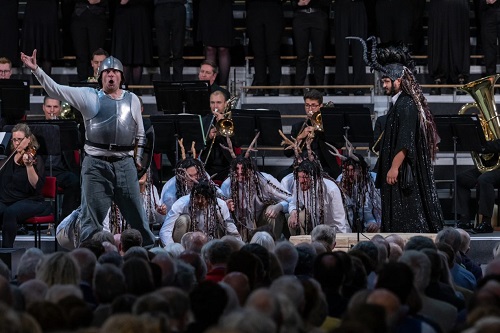
The confrontation between the Pilgrim and the monster Apollyon in the Valley of Humiliation was a veritable dramatic and musical peak, Armand Rabot – tremendously dreadlocked and horned – delivering Apollyon’s monotonous recitative with quasi-Wagnerian portentousness. Kerley did his best with the Vanity Fair scene, bringing colour, texture and movement into the dissolute mix. But, The Rake’s Progress this is not, and it didn’t help that Gabriel Seawright’s Lord Lechery, attired in louche red dressing-gown, didn’t always carry, nor that the Sins who tempt the Pilgrim – and this is not the singers’ fault – are neither strongly individualised nor very tantalising. One doesn’t feel that it would take much to conquer the excesses of liberalism embodied by this Vanity Fair.
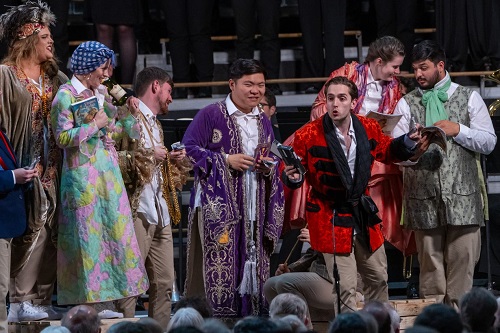
There were other striking performances, even in the smaller roles, and not least from Angelina Dorlin-Barlow as the Woodcutter’s son. Her meeting with the Pilgrim was a moment of real human intimacy (even if her words were not always clear) aided by beautiful melodising by the solo horn. Dorlin-Barlow’s unaccompanied “Farewell, I wish you a fair day when you set out for Mount Zion” and the subsequent beautiful clarinet solo conveyed every atom of the promise of bliss that the conclusion of the pilgrimage will bring. Similarly, in the Delectable Mountains scene, Issy Bridgeman sang, from the top of the choir screen, with crystalline purity as Voice of a Bird (we could have done without the puppet bird-on-a-wire though).
The Three Choirs Festival Youth Choir chorus (it was nice to think that Charlotte Corderoy was a member not so long ago) did sterling work, singing with accuracy and commitment. They sometimes seemed to lack the necessary punch though, and this was a pity as they have such an important role in many scenes: in the arming scene, when a choral episode precedes the Pilgrim’s confrontation with Apollyon; in the Vanity Fair scene where their cries – “Buy! Come and buy! ” “Vanity!” “Beelzebub” – lacked the portentousness and power which should precede the judgment of the Pilgrim by Lord Hate-Good, and which recall the disordered turba of Bach’s Passions; and when the Celestial voices sing praises of “Allelluia”, confirming the Pilgrim’s transcendence.
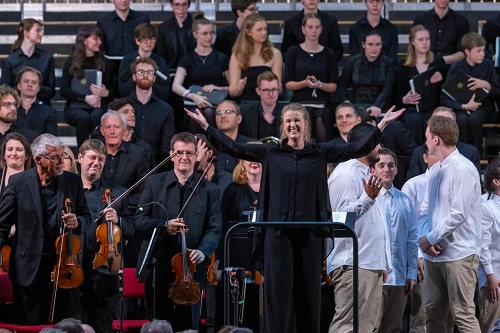
Conductor Charlotte Corderoy was committed, assured and incisive. Her gestures, informed by knowledge and insight, were clear, unfussy and economical, and she was absolutely precise in communicating what she wanted to achieve, inspiring really engaged playing from the RPO. The Pilgrim’s Progress is a difficult work to pace and structure, but one sensed no such difficulties here. Corderoy summoned vigour and heft when it was required, and the victory against Apollyon was a stirring climax. But, she also assuredly brought calm to the more spiritual moments: the ebb and flow of the House of Beauty scene was lovingly articulated. She didn’t let the momentum flag, even in the Vanity Fair scene. What was striking was the way she conjured a real sense of a journey, the various episodes cohering and seeming almost through-composed: for example, in the interlude between the arming scene and the meeting with Apollyon the change of tenor from triumphant to portentous was skilfully handled; similarly, the funereal march at end of the Vanity Fair scene effectively drew the threads together. Corderoy had the overall structure of the work under her belt, too: in ‘The Shepherds of the Delectable Mountains’ the reprise of earlier material was made familiar and comforting, and Corderoy drew lovely solos from the cello, flute and viola, a solo string quartet meaningfully underlying the unified message of the three shepherds, “Who so dwelleth under the defence of the Most High shall abide under the shadow of the Almighty”.
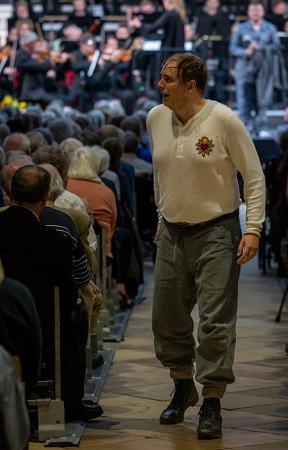
Kerley’s handling of the Epilogue was deeply gratifying, creating a sense that we had not only witnessed an individual journey but that we had participated in a parable. Vaughan Williams’ Epilogue offers a spirituality that each and every one can interpret and embrace as they so wish. The Pilgrim is alone in his transcendence, but as Cumming departed for the Celestial City down the Cathedral’s central aisle, we seemed invited to seek our own salvation. I was put in mind of the words of W.H. Auden, in a 1934 article, ‘Psychology and Art Today’: ‘You cannot tell people what to do, you can only tell them parables; and that is what art really is, particular stories of particular people and experiences, from which each according to his immediate and particular needs may draw his own conclusions.’
Claire Seymour
Ross Cumming – Pilgrim, Emyr Lloyd Jones – Bunyan / Evangelist / Watchful / First Shepherd, Matthew Curtis – Interpreter / Usher / Mister By-Ends / Second Shepherd, Jia Huang – Obstinate, Herald, Lord Hate-Good, Armand Rabot – Mistrust / Apollyon / Envy / Third Shepherd, Gabriel Seawright – Timorous / Lord Lechery / Messenger, Issy Bridgeman – First Shining One / Madam Wanton / Voice of a Bird / Third Celestial Voice, Charlotte Jane Kennedy – Second Shining One / Branch Bearer / Malice, Angelina Dorlin-Barlow – Third Shining One / Cup Bearer / Pickthank / Woodcutter’s Boy, Lydia Shariff – Madam Bubble / Madam By-Ends / Second Celestial Voice, Zihua Zhang – Pliable / Superstition/ First Celestial Voice, Jonathan Kennedy – Demas, David Corr – Worldly Glory, Michael Roche – Pontius Pilate; Director – Will Kerley, Conductor – Charlotte Corderoy, Royal Philharmonic Orchestra, Festival Youth Choir
British Youth Opera/Three Choirs Festival, Gloucester Cathedral; Monday 24th July 2023.
ABOVE: Ross Cumming (Pilgrim) (c) James O’Driscoll